#Canaanite Polytheism
Explore tagged Tumblr posts
Text
Two prayers from ancient Ugarit

Various “Teraphim” figures representing deities for devotional purposes from ancient Canaan/Judah. Photo from “Exhibit from the Bible Lands Museum” (Biblical Archaeology Review Vol. 25:5 (Sep.–Oct. 2000), p. 22). Source: Fertility Goddesses from the Ancient Near East (Mar. 2000) by Wanda Roux, https://www.semanticscholar.org/paper/Fertility-goddesses-from-the-Ancient-Near-East-Roux/218a301d5b1f807dd2324e37257cc817912ceeed.
Shulmu 𒁲𒈬 to all! These are a couple more Ugaritic prayers I've given my own take on and filled in blanks based on scholarly texts. The first of these is addressed to 𒀭Prince Ba'al and is found appended to a bimonthly itinerary of Temple rituals classified as KTU 1.119 (=RS 24.266). My source for the text is Pardee 2002 (I mention these works often enough I figure I'll probably make a bibliography), pp. 50–53, 149–50 and the translation in Wyatt 2002, pp. 416–22. The next prayer, found on tablet KTU 1.65 (Wyatt 2002, pp. 363–65), also has a liturgical character and appears to have originally been concerned with the wellbeing of the a City of Ugarit. I've tried to adjust language in both prayers to make them flow as well as possible in English with a distinct ancient tone and I really hope you like what I've got here.
Prayer to Ba'al for Protection
When a terrible foe storms your gate,
a marauder dashes your walls,
You shall lift up your eyes to 𒀭Ba'al and say:
“O 𒀭Ba'al, if You drive the terrible foe from our gate,
“banish the marauder from our walls,
“an offering, O 𒀭Ba'al, we shall sanctify,
“a vow, O 𒀭Ba'al, we shall fulfill;
“a heritage, O 𒀭Ba'al, we shall sanctify,
“a Propitiation, O 𒀭Ba'al, we shall fulfill,
“a feast, O 𒀭Ba'al, we shall offer;
“to the Sanctuary, O 𒀭Ba'al, we shall ascend,
“the paths of the Temple, O 𒀭Ba'al, we shall follow.”
and 𒀭Ba'al will hear your prayer:
He will drive the terrible foe from your gate,
banish the marauder from your walls.
Prayer to El and the Family of the Gods
O Gods of the House of 𒀭El,
Family of the Gods,
Assembly of the Gods,
𒀭Thukamuna and 𒀭Shunama.
O 𒀭EI and 𒀭Ashirat,
Show us grace, O 𒀭El,
Come to our assistance, O 𒀭El,
Grant us peace, O 𒀭EI.
𒀭EI, come close,
𒀭EI, be our guard,
for the love of 𒀭Ba'al of Sapon,
for the hope in 𒀭Ba'al of Ugarit.
By the Holy Spear,
by the Holy Axe,
by the Holy Mace,
by the Holy Javelin.
By the Holy Burnt-Offering,
by the Holy Perpetual Offering,
by the Holy Morning Offering,
by the Holy Evening Offering.
By the Holy Censer and Lyre,
by the Holy Image and Propitiation,
by the Holy Threshold and Keystone,
by the Holy Song and Scribal Instruments,
by the Holy Grain-Offering and Young Wine.
O Gods of the Holy Mountain,
Gods and Goddesses in the Dwelling and Court,
remember us at the Assembly in Council,
by your rulings grant us peace in your good time.
#semitic pagan#semitic paganism#pagan#paganism#ancient history#ancient near east#history#canaanite paganism#canaanite pagan#canaan#canaanite#el#asherah#baal#gods#goddess#goddesses#spirituality#polytheism#polytheist#canaanite polytheism#ugarit#ancient levant#faith#religion#ancient religion#ancient world#phoenicia#bronze age#ugaritic
12 notes
·
View notes
Text
I'm here for goth girl Anat

Are you?
#esoterica#anat#canaanite mythology#canaanite polytheism#ugaritic mythology#ugaritic polytheism#paganism#war gods#esoteric shitposting
13 notes
·
View notes
Text
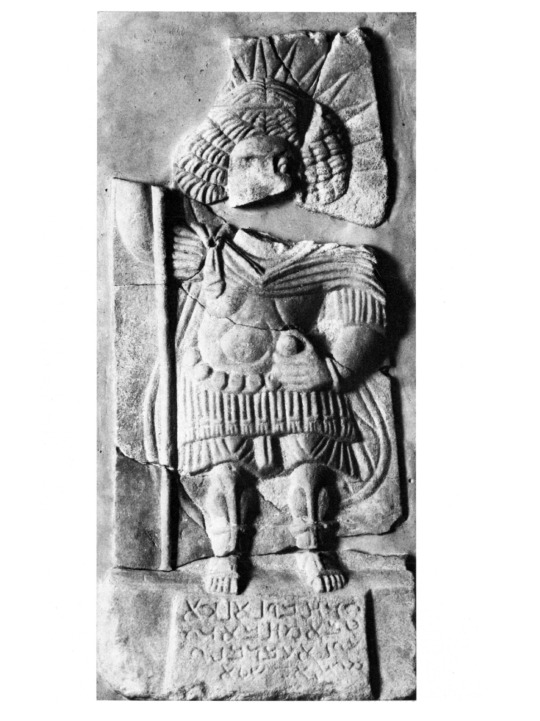

Yarhibol, the Sun-God Dura-Europos, Syria c. 50 CE Source: The Pantheon of Palmyra by Javier Teixidor, 1979
#yarhibol#dura europos#canaanite paganism#canaanite polytheism#canaanite gods#levantine paganism#phoenician#phoenician paganism#phoenician polytheism#phoenician gods#syrian paganism#syrian polytheism#syrian gods#natib qadish#pagan#paganblr#paganism#polytheism#witchcraft#witchblr#magic#occult
84 notes
·
View notes
Photo
Huh, I remember reading about this being a statue of Astarte.

Babylonian Alabaster Statue of the goddess Ishtar, 350 B.C.
10K notes
·
View notes
Text
Ok so back a few years ago, maybe more like 5?
There was a levpag content creator who made collaged images of the gods and now I can’t find their work. I was trying to specifically find the images for Ashera/Athirat and El/Ilu.
Are you still out there? Do you still publish these images for community use?
0 notes
Text

I seriously don’t understand why more people aren’t talking more about this. I think it’s interesting!
https://academia.edu/resource/work/122323191
#AddsContext
(Academia.edu = #academic papers)
#CanaaniteReligion, #UgaritReligion, #El, #Yahweh, #polytheism, #monolatry, #monotheism, #HistoryOfReligion
#CanaaniteReligion#Canaanite Religion#UgaritReligion#Ugarit Religion#UgariticReligion#Ugaritic religion#El#Yahweh#polytheism#monolatry#monotheism#HistoryOfReligion#history of religion#comparative relligion#biblical scholarship
22 notes
·
View notes
Text
Steven Dillon's conversion to Christianity: what does it mean to Hellenism and Pagan Community?
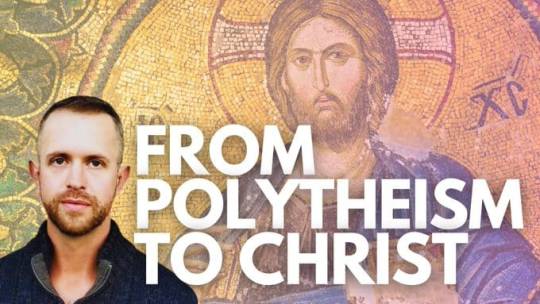
Steven Dillon, the author of "The Case for Polytheism" and "Pagan Portals - Polytheism: A Platonic Approach", recently returned to Christianity.
This event made me think a lot. I think this event can teach us that the more you are concerned with "the One" and you think it can respond, the more likely you will go towards monotheism.
The point is that "the One" is us, and is "a thing", not "somebody".
The One is not a person. This is the reason why we worship the Gods, they are persons.
The One, the All, is so big that the idea that it can listen is nonsense.
Monotheism emerges when you think the entire universe can listen to you. Polytheism is the humbleness to understand that only certain parts of the Universe can listen to you.
And when you think you are talking to the One you are always actually talking to a part of it.
This is the reason why Christ, Yahweh, Allah, etc. are parts of the One and not the One.
Even attempts to interact with the entirety of the One are just interactions with parts of the One, ie one of the many Gods.
This is confirmed by Aleister Crowley's experience, we can read from the Liber Astarte Vel Berylli that he considered Allah, Christ and Yahweh as Parts or Aspects of the One, exactly as other Polytheistic Deities, and not as the All/the One in its entirety:
"Let the devotee consider well that […] Christ and Osiris be one […]".
"As for Deities with whose nature no Image is compatible, let them be worshipped in an empty shrine. Such are Brahma, and Allah. Also some postcaptivity conceptions of Jehovah".
"[…] the particular Deity be himself savage and relentless; as Jehovah or Kali."
-
Moreover, Dillon was (is?) Platonic, and the problem is even worse, because sadly the reaction to the problem of evil is very similar between Platonism and Christianity.
However, the Stoic (and maybe the Hindu and Buddhist) worldview completely destroys the problem of evil, because if the Divine is good and we simply don't perceive the goodness and that is what evil is, ie ignorance or misperception, then the problem of evil is solved.
If we, instead, perceive the evil as something real and the Gods as totally good not evil, the problem of evil remains.
-
Finally, a Pagan that comes back to Christianity usually doesn't know history very well, and is unaware of Natib Qadish, ie Modern Canaanite Religion or Neopaganism.
If you listen to Natib Qadish (ie Canaanite and Israelite Polytheistic Neopaganism) and Wathanism (Arabian pre-Islamic Polytheistic Neopaganism) practitioners' voices, you cannot come back to Christianity.
In fact, Christianity doesn't make any sense: Yahweh is a Storm God that comes from Edom to Israel through the Kenites or Shasu, which were nomads. His name meant "to blow", and so he was a variation of Baal Hadad.
In the origin, El was the father of Baal/Yahweh, and his sister was Anat and his mother Asherah. Later, El ie the Sky God and Yahweh ie the Storm God, merged and so Yahweh was seen as the husband of the Goddess Asherah.
In fact in Kuntillet Arjud it's possible to see blessings by "Yahweh and his Asherah". Moreover, even the Bible (read The Book of Judges) witness that people worshipped Asherah/Astarte and Baal together with YHWH.
In Elephantine in Egypt there was a Jewish temple for Yahu-Anat, ie both Anat and YHWH.
So how can Jesus be the son of the only God Yahweh if Yahweh was never a monotheistic God before the Josiah's reform that made Judaism monotheistic?
If Judaism is originally polytheistic then Christianity makes no sense.
By reading the "Cycle of Baal" we'll discover the origin of the Biblical Deity (or Deities?).
youtube
I end my dissertation with some interesting quotes from the Bible:
Jeremiah 7:
"17 Do you not see what they are doing in the towns of Judah and in the streets of Jerusalem? 18 The children gather wood, the fathers light the fire, and the women knead the dough and make cakes to offer to the Queen of Heaven."
Jeremiah 44:
"17 We will certainly do everything we said we would: We will burn incense to the Queen of Heaven and will pour out drink offerings to her just as we and our ancestors, our kings and our officials did in the towns of Judah and in the streets of Jerusalem. At that time we had plenty of food and were well off and suffered no harm. 18 But ever since we stopped burning incense to the Queen of Heaven and pouring out drink offerings to her, we have had nothing and have been perishing by sword and famine.”
"19 The women added, “When we burned incense to the Queen of Heaven and poured out drink offerings to her, did not our husbands know that we were making cakes impressed with her image and pouring out drink offerings to her?”"
"25 This is what the Lord Almighty, the God of Israel, says: You and your wives have done what you said you would do when you promised, ‘We will certainly carry out the vows we made to burn incense and pour out drink offerings to the Queen of Heaven.’"
#Hellenism#Paganism#Polytheism#devotional polytheism#Christianity#Canaanite#Platonism#Neoplatonism#Natib Qadish#Youtube
35 notes
·
View notes
Note
#and the worst part is…#sometimes you don’t have a choice(via@a-book-of-creatures) Yeah (:T
Hi, sorry if this has been asked before, but do you have any reliable sources that talk about Ashtar? I'm also looking for articles that talk about El/Ilu; and Shalim and Shahar as well. I appreciate any form of help.
I've answered a similar Ashtar question a few months ago, refer to the bibliography here. I do not have much to offer when it comes to Shahar and Shalim because as far as I can tell most scholarship focuses on exegesis of the Bible, which is something I have next to no interest in. I've answered a question about them here; the main source to depend on is Pardee's Ritual and Cult in Ugarit. When it comes to El, the basic selection of sources dealing with Ugaritic religion should obviously be the start: Smith's Baal Cycle commentaries, Pardee's aforementioned book, Rahmouni's Divine Epithets in the Ugaritic Alphabetic Texts, Handbook of Ugaritic Studies, etc. For more specialized information I recommend: a) Il in Personal Names by Alfonso Archi (early history, and why names with the element il and its cognates do not necessarily refer to a specific deity in pre-Ugaritic sources) b) West Semitic god El in Anatolian Hieroglyphic Transmission by Ilya Yakubovich for the first millennium BCE c) The God Eltara and the Theogony by Anna Maria Polvani for El's Hurro-Hittite career (there's also the Elkunirsa myth but I do not think there's any recent treatment of it, so your best bet is to just read the translation in Hoffner's Hittite Myths from the 1990s) d) The Dwelling of ˀIlu in Baˁlu and ˀAqhatu by Madadh Richey for some lexical considerations regarding El's residence e) God (Ilu) and King in KTU 1.23 by Theodore J. Lewis for El's role as the king of the gods
Also, it's worth checking out Wiggins' monograph A reassessment of Asherah: with further considerations of the goddess since while hardly focused on El, it does discuss Athirat's relationship with him in the Ugarit section. Similarly, might be worth looking into this author's Shapash article.
#yamayuandadu#Asherah#Ashtar#Ishtar#Shalim#Shahar#Canaanite Polytheism#Mesopotamia#Ugaritic Mythology#Mesopotamian Myth#Sources#informative reblogs
45 notes
·
View notes
Text
A suggestion from someone new to Canaanite Paganism
This sort of ties in to some local cultus kind of deal, but with Halloween coming up I was thinking about adding a Canaanite flavor.
Now this is sort of UPG but bear with me here. If you're a Canaanite pagan, you probably know about Mot.
He's the spooky God of death, always hungry for pretty much anything and everything (man or God alike), and he received absolutely ZERO offerings or worship. So around this time of year it could be that M/t is at his worst, looking for prey. Carve a scary face in a gourd or some other vegetable to scare him away.
Sort of like the ritual that pruned him like a grapevine.
#pagan#polytheism#witchblr#witchcraft#witch#paganblr#canaan#canaanite paganism#levpag#levantine#paganism
7 notes
·
View notes
Text
Deity Dagan
Originally a god of West Semitic speakers from the Levant, but worshipped widely throughout the Near East, including Mesopotamia.
Deity of grain, as well as its cultivation and storage. Indeed, the common word for "grain" in Ugaritic and Hebrew is dagan. According to one Sumerian tradition and to the much later Philo of Byblos, Dagan invented the plow. In the north, he was sometimes identified with Adad. Thus, he may have had some of the characteristics of a storm god. In one tradition his wife was Ishara, in another Salas, usually wife of Adad. Salas was originally a goddess of the Hurrians. Dagan also had netherworld connections. According to an Assyrian composition, he was a judge of the dead in the lower world, serving with Nergal and Misa-ru(m), the god of justice. A tradition going back at least to the fourth century BCE identified Dagan as a fish god, but it is almost certainly incorrect, presumably having been based upon a false etymology that interpreted the element "Dag" in Dagan as deriving from the Hebrew word dag "fish."
The earliest mentions of him come from texts that indicate that, in Early Dynastic times, Dagan was worshipped at Ebla. Dagan was taken into the Sumerian pantheon quite early as a minor god in the circle of Enlil at Nip-pur. Kings of the Old Akkadian peri-od, including Sargon and Narām-Sin, credited much of their success as conquerors to Dagan. Sargon recorded that he "prostrated (himself in prayer before Dagan in Tutul [sic]" (Oppen-heim, ANET: 268). At the same time, he gave to the god a large area of the country he had just conquered, including Mari, Ebla, and larmuti in western Syria. A number of letters from the Mari archives, dated mainly to the reign of Zimri-Lim, record that Dagãn was a source of divine revela-tion. The letters reported prophetic dreams, a number of which came from Dagan, conveyed by his prophets and ecstatics. In his law code, Hammu-rapi credits Dagan with helping him subdue settlements along the Euphrates.
The Assyrian king Samsi-Adad I commissioned a temple for him at Terqa, upstream from Mari, where funeral rites for the Mari Dynasty took place.
In the Old Babylonian period, kings of the Amorites erected temples for Dagan at Isin and Ur. In the Anzû(m) myth, Dagan was favorably coupled with Anu(m). At Ugarit Dagan was closely associated with, if not equated to, the supreme god El/I(u). Although he is mentioned in the mythic compositions of Ugarit as the father of the storm god Ba'lu/ Had(d)ad, Dagan plays only a very minor role. His popularity is indicated by his importance in offering and god lists, one of which places him third, after the two chief gods and before the active and powerful god Ba'lu/ Had(d)ad. Dagan is attested in Ugaritic theophoric names. In Ugaritic texts the god is often referred to as "Dagan of Tuttul." It might also be the case that one of the two major temples of the city of Ugarit was dedicated to him, and he might there have been identified with the chief god I(u) / El.
Festivals for Dagãn took place at Ter-ga and Tuttul, both of which were cult centers of the god. He was certainly worshipped at Ebla and also at Mari.
At Mari, in Old Babylonian times, he appears as fourth deity on a god list; that is, he was very important. He was venerated also at Emar. There a "Sacred Marriage" ritual between Dagan and the goddess Nin-kur was celebrated.
At the same city, a festival was held in honor of "Dagan-Lord-of-the-Cattle," at which the herds of cattle and prob. ably sheep were blessed.
According to the Hebrew Bible, Dagan was the national god of the Philistines. I Samuel:5-6 tells of the capture of the Ark of the Covenant by the Philistines. It was customary in the Ancient Near East for the conquerors to carry off the deity statues of the conquered to mark the surrender not only of the people, but also of their deities.
So the Philistines took the Ark, the symbol of the god of the Israelites, into the temple of Dagan at Ashdod. Since the Israelites had no statues of their deity, the much revered Ark was an obvious substitute. In this way, the Philistines marked the submission of the Israelite god to Dagan. However, on the next day, the people of Ashdod found the statue of Dagan lying face down in front of the Ark. The following day the same thing happened except that the head and hands of Dagan's statue lay broken on the temple threshold. This biblical account seems to be an etiology for a practice of the priests of the temple of Dagan at Ashdod, for it states that for this reason it is the custom of the priests of Dagan not to tread on the threshold as they enter the temple of Dagan. The best-known of the biblical stories that mention Dagan is in Judges 16, the tale of Samson and Delilah. After Delilah arranged for the Philistines of Gaza to capture Samson, they blinded him, shackled him, and made him a slave at a mill. During a festival to Dagan, the Philistines took Samson to be exhibited in Dagan's temple, where thou sands of Philistines had gathered for the celebrations. After praying to the Israelite god, the now long haired Samson got back his old strength. By pushing against two central pillars, he brought the temple crashing down on himself and on more Philistines than he had killed in his whole lifetime of killing Philistines.
— From a Handbook to Ancient Near Eastern Gods & Goddesses by Frayne & Stuckey page 67-69
#pagan#polytheism#levpag#philistines#israelites#canaanites#assyrians#1 samuel#tanakh#mesopotamians#dagan#dagan deity#deity#god#quote#sumerian polytheism#levant#ancient near east#landof2rivers#quote pile#put this in text for someone so thought id post it#eblaite#ebla
10 notes
·
View notes
Text
The funniest neopagan religion to found would be neopagan ancient Israelite religion (El and Yahweh as distinct deities, restoring the worship of Asherah, etc), since ancient authorities spent so much time trying to shift the Israelite flavor of Canaanite polytheism to a monotheistic footing. And because of the literary layers of the Hebrew bible and the rich archeology of the ancient Near East, you could probably cobble together something that was more historically informed than like Slavic or Celtic or even Norse neopaganism. It would also be fun to try to come up with a modern version of the one-god-for-every-nation scheme present in some parts of ancient Semitic cosmology. Maybe modern nations could inherit ancient gods, or maybe you could just treat major gods of various national myths as the guardian deities of each nation.
270 notes
·
View notes
Text
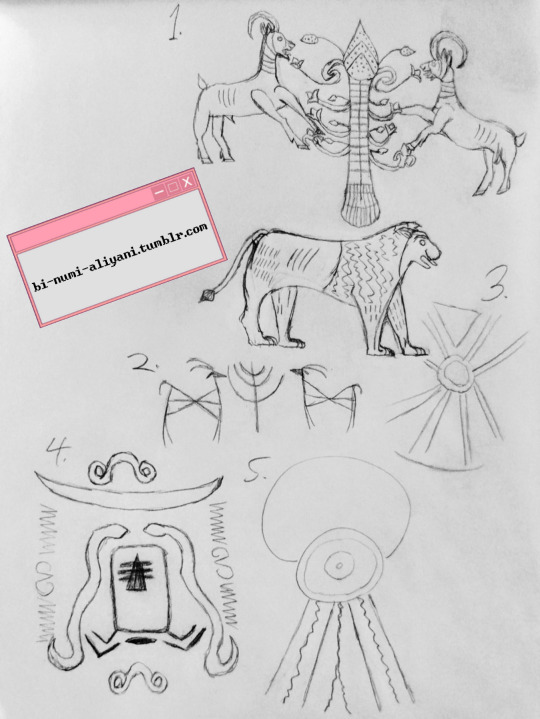






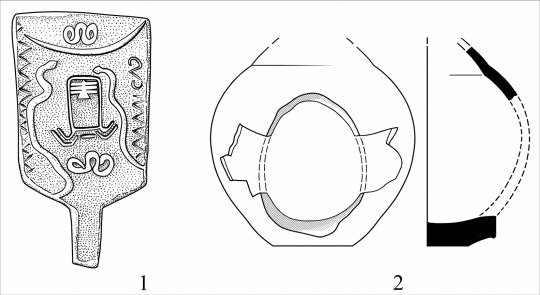


Hello, friends! I apologize for my absence as of late, I unfortunately ended up in a situation where I didn't have access to the internet for a little while and had to get everything sorted out. There's a lot of things I'm excited to do here, but for now I'd just like to hopefully make up for it with these sketches of ancient symbols of 𒀭El-Elyon and 𒀭Lady Ashirat :)
Great Seal of 𒀭Ashirat: This is the Asherah-tree symbol as it appears on the famous Pithos A from the Kuntillet Ajrud site. It probably came from around the early 8th century BCE when the former Judean outpost was under Northern Israelite control and bears a now-famous inscription mentioning “𒀭Yahweh of Samaria and His 𒀭Asherah.” The ornately-depicted Sacred Tree nourishes two flanking ibex, the sacred animal of 𒀭Ashirat, and rests above a lion which symbolizes a Deity's strength in ancient Canaanite iconography.
Small Seal of 𒀭Ashirat: This more simplistic iteration of the Tree-and-Ibex symbol is found on the famous Lachish ewer from the end of the Bronze Age and is most notable for its remarkable resemblance to the Menorah of the later Temple of 𒀭Yahweh at Jerusalem.
Small Solar Seal of 𒀭El: This design is found on the head of a sceptre held by a bronze seated figurine of 𒀭El in intact gold leaf from a Bronze-Age Temple at Megiddo (Tel Megiddo). It was made around the same time as the Lachish ewer and is believed to invoke the Sun and its beams in a similar way to more recognizable Egyptian or Mesopotamian solar symbols. Another theory holds that it depicts a flower.
Seal of the House of 𒀭El: Yet another 13th century BCE find, this peculiar insignia is featured on a bronze sceptre head coated in silver leaf which would have been inserted into a wooden pole to be grasped by a life-sized cult statue of 𒀭El. A stylized human face is flanked by serpents and zigzag lines topped with an upturned crescent. At the bottom and the top is another sign resembling the omega-shaped womb symbol originally associated with the Mother Goddess 𒀭Ninhursag of the Sumerian Pantheon (cf. the cow uterus headdress of the ancient Egyptian childbirth Goddess 𒀭Meskhenet and the “Hathoric curls” hairstyle associated with 𒀭Lady Ashtart and 𒀭Qadesh). This design was described as a “cult standard” by the archaeological team who discovered it in a destruction layer at Hazor (Tel Hazor) in the 1950s and I've interpreted it to symbolize the House of 𒀭El which is also the House of all the Gods and Goddesses. The artifact was found in what appeared to be a small shrine indicating it possibly received some kind of veneration of its own.
Great Solar Seal of 𒀭El: This is from another bronze sceptre head with silver leaf and was discovered in a 12th century BCE layer at the site of a Canaanite Temple in Lachish (Tell ed-Duweir). I've followed the interpretation that this is a solar symbol similar to the one from Megiddo. A solar disc with three nesting circles is backed by a sort of oblong "halo" which represents the Firmament of Heaven in my view. The Sun with its life-giving rays shown descending upon the Earth here has been interpreted as an anthropomorphic figure as well. I can also see the broad outer bands and the thin inner streams having to do with 𒀭El's Abode of Mount Lalu being located “at the Source of the Two Rivers, at the Confluence of the Channels of the Two Deeps” according to Ugaritic texts.
Thanks so much for checking this out!
My source for the pictures of and information on the 𒀭El sceptres is ���The sceptres of life-sized divine statues from Canaanite Lachish and Hazor” by Yosef Garfinkel in Antiquity 94:375 (2020), pp. 669–685, https://doi.org/10.15184/aqy.2020.44.
#pagan#paganism#semitic pagan#semitic paganism#polytheism#polytheist#canaanite polytheism#canaanite paganism#canaan#canaanite#el#athirat#asherah#bronze age#late Bronze age#ancient near east#history#ancient history#religion#faith#spirituality#gods#mother goddess#sacred tree#ancient levant#archaeology#lachish#hazor#kuntillet ajrud#megiddo
11 notes
·
View notes
Photo

Jezebel
Jezebel (d. c. 842 BCE) was the Phoenician Princess of Sidon who married Ahab, King of Israel (r. c. 871 - c. 852 BCE) according to the biblical books of I and II Kings, where she is portrayed unfavorably as a conniving harlot who corrupts Israel and flaunts the commandments of God.
Her story is only known through the Bible (though recent archaeological evidence has confirmed her historicity) where she is depicted as the evil antagonist of Elijah, the prophet of the god Yahweh. The contests between Jezebel and Elijah are related as a battle for the religious future of the people of Israel as Jezebel encourages the native Canaanite polytheism and Elijah fights for the monotheistic vision of a single, all-powerful male god.
In the end, Elijah wins this battle as Jezebel is assassinated by her own guards, thrown from a palace window to the street below where she is eaten by dogs. Her death, the biblical authors note, was prophesied earlier by Elijah and is shown to have come to pass precisely according to his words and, so, in accord with the will of Elijah's god.
Her name has become synonymous with the concept of the evil seductress owing to the interpretation of some of her actions (such as putting on make-up in order to, allegedly, seduce her adversary Jehu, who is anointed by Elijah's successor, Elisha, to destroy her) and calling a woman a “jezebel” is to label her as sexually promiscuous and lacking in morals.
Recent scholarship, however, has tried to reverse this association and Jezebel is increasingly recognized as a strong woman who refused to abide by what she saw as the oppressive nature of her husband's religious culture and tried to change it.
Jezebel's Changing Reputation
The story as given in I and II Kings presents Jezebel as an evil influence from the moment of her arrival in Israel who corrupts her husband, the court, and the people by trying to impose her “godless” beliefs on the Chosen People of the one true god. I Kings 16: 30-33 presents King Ahab as a wicked king seduced by the corrupting influence of his new wife and is an audience's introduction to the story:
Ahab, son of Omri, did more evil in the eyes of the Lord than any of those before him. He not only , but he also married Jezebel, daughter of Ethbaal, king of the Sidonians, and began to serve Baal and worship him. He set up an altar for Baal in the temple of Baal that he built in Samaria. Ahab also made an Asherah pole and did more to arouse the anger of the Lord, the God of Israel, than did all the kings of Israel before him.
Traditionally, the story of Jezebel is one of a corrupting influence on a king who had already shown himself a poor representative of his kingdom's religious culture. The biblical account assumes a reader's knowledge that Jezebel, coming from Sidon, would have worshipped the god Baal and his consort Astarte along with many other deities and also assumes one would know that the polytheism of the Sidonians was comparable to that of the Canaanites prior to the rise of Israel and monotheism in their land. Since monotheism and the kingdom of Israel are presented in a positive light, Jezebel, Sidon, and Ahab are cast negatively.
It could be that the biblical narrative depicts events, more or less, accurately but this view is challenged by modern-day scholarship which increasingly leans toward a new interpretation of the clash between Jezebel and Elijah as demonstrating the conflict between polytheism and monotheism in the region during the 9th century BCE. In this interpretation, Jezebel is understood as a princess, the daughter of a king and priest, trying to maintain her cultural heritage in a foreign land against a religion she could not accept. The historian and biblical scholar Janet Howe Gaines comments:
For more than two thousand years, Jezebel has been saddled with a reputation as the bad girl of the Bible, the wickedest of women. This ancient queen has been denounced as a murderer, prostitute and enemy of God, and her name has been adopted for lingerie lines and World War II missiles alike. But just how depraved was Jezebel? In recent years, scholars have tried to reclaim the shadowy female figures whose tales are often only partially told in the Bible. (1)
Although she has been associated with seduction, depravity, and harlotry for centuries, a more accurate understanding of Jezebel emerges as one considers the possibility she was simply a woman who refused to submit to the religious beliefs and practices of her husband and his culture. The recent scholarship, which has led to a better understanding of the civilization of Phoenicia, the role of women, and the struggle of the adherents of the Hebrew god Yahweh for dominance over the older faith of the Canaanites, suggests a different, and more favorable, picture of Jezebel than the traditional understanding of her. The scholarly trend now is to consider the likely possibility she was a woman ahead of her time married into a culture whose religious class saw her as a formidable threat.
Continue reading...
89 notes
·
View notes
Text
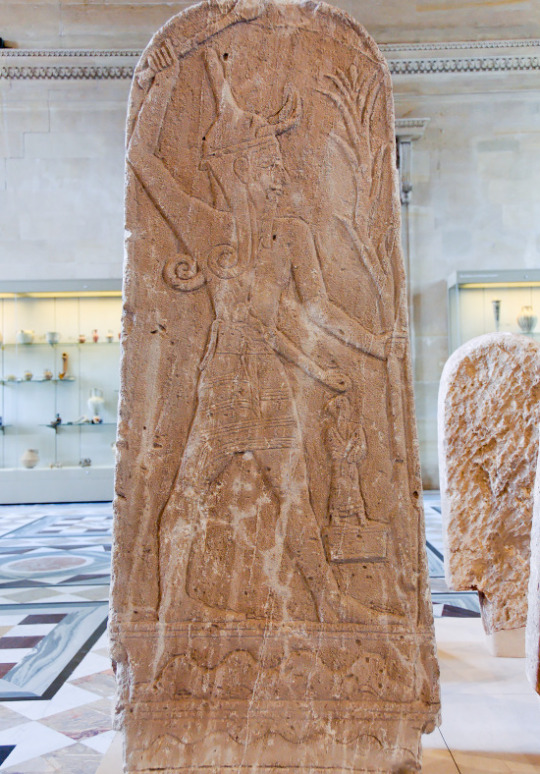
Baal Hadad, God of Storms and Fertility Stele from Tel Burna, Shephelah c. 1400 BCE Source: The Louvre
#baal#hadad#balu#haddu#canaan#canaanite#canaanite paganism#canaanite polytheism#canaanite gods#phoenician#phoenician paganism#phoenician polytheism#phoenician gods#aramean#aramean paganism#aramean polytheism#aramean gods#natib qadish#pagan#paganism#polytheism#magic#witchcraft#occult
127 notes
·
View notes
Text

✧ Introduction to Yahwism ✧
Yahwism is a iron age religion from the Isrealite tribe from before the existence of Israel. According to the story, the Israelites were saved from slavery in Egypt when the god, Yahweh, came to set them free. Yahweh had become the god of the Israelites. As the Israelites met the Canaanite tribe, they adopted the worship of the gods El and Ba'al along with the goddess Asherah. Asherah had been seen as being the consort of Yahweh. As time went on, prophets of Yahweh and the rest of the Israelites, began becoming unhappy with worshipping other gods along side Yahweh so they destroyed idols of Asherah and banned the worship of the other gods, though this did not completely stop the worship of them. The Israelites saw Yahweh as the only deity worth worshipping in their tribe so they abandoned polytheism but still being aware of the existence of the other gods. As time went on and Israel came to be, Judaism and Christianity branched off from Yahwism but Yahwism is absolutely NOT Judaism or Christianity. Yahwists only follow the teachings of the Tanakh (hebrew old testament) as it was the first bible. Yahwists do believe in Jesus but only as a prophet and only use his original name, Yahshua. Yahshua only said he was the son of Yahweh but as a metaphor for being a believer and follower.
Differences:
Yahwism
~ Focus is Yahweh and His holy spirit
~ Follows the Tanakh
~ Yahshua (Jesus) is only a prophet
~ There is no hell, either eternal life for the worthy or eternal oblivion for the non-worthy
~ Using the labels "God" or "Lord" is seen as disrespect as they are not Yahweh's name
Christianity
~ Believes in the holy trinity, Jesus is a form of God
~ Uses the labels "God" and "Lord"
~ Contains the new testament, which is Roman in origin
~ Believes in hell
~ Celebrates easter, christmas, etc.
~ Uses holy water and holy oil
~ Believes in judgement day
Judaism
~ Uses the labels "God" and "Lord"
~ Believes using the name "Yahweh" is disrespectful and too divine to be said
~ Not much focus on the afterlife, focus is life on earth
~ Follows the Tanakh
~ Celebrates chanukah
36 notes
·
View notes
Text
Christianity to me is so unserious. Now, I don’t think that Christians serve Yahweh. I know that Jewish people serve the deity, but I don’t think most Christians research enough about the history of their god to know what the fuck is going on. Like some arrogant Christian will equate “El” with “Yahweh” and it’s like “you dumb mf, EL was the creator god in Ancient Canaanite religions”, mfs just believe whatever makes them feel good. A lot of Christians are terrified to even call Yahweh his/their name. I’m not. I know that Yahweh was a Canaanite storm god, and like a lot of early polytheism, he was worshipped by Canaanites and Jewish people of that era. His reach evolved as Christianity became a thing and it evolved. The average Christian doesn’t know this. No hate to them, but I take religions serious so I feel like I have to know this.
And with that in mind, I think the entire concept of an all powerful, all knowing god is so mf childish and stupid. Historically, gods had vices and flaws. Also, why would a god torture me for eternity just because I don’t fw him? Seems really man made, psychological torture to me. Like, plenty of Apes can comprehend the world at a 2nd/3rd grade level and that’s the age a lot of mfs get converted at. So is god gon send them to hell? Elephants have names and burial ceremonies, mfs aren’t converting them. Crows can make tools and have lil insular societies. Nobody give a fuck about them. Whales are super intelligent, like we’re just learning about how smart they are. Nobody is rushing to convert them over.
It’s almost like Christianity (as white people have used it) is an tool for mfs to gain power and subjugate others. “Oh those really intelligent animals aren’t important. We have dominion over them so even tho us and them share similar practices, we’re better so they can’t have a soul” dumbass mf you’re giving the game away. If your god gon send me to eternal hell for no reason (bc you can be a murderer rapist, tell god sorry, and face no eternal punishment, which is insane and not even how laws work) then I’m not gon fw him anyways. Even if he was real, which he’s not in the way that most Christian’s imagine him.
Christians really worship their own ego, and a mf like me has an ego but I don’t need every bitch on planet earth to lead the life I do. I’m too nonchalant to try to force my beliefs on a mf lmao
6 notes
·
View notes